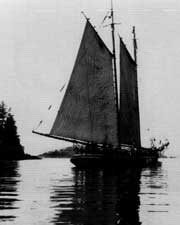EXTRACT FROM ROBERT LOUIS STEVENSON: A BIOGRAPHY

Towards dawn on 28 July, the magical moment arrived when land was sighted; the distant volcanic peak of Ua-huna. ‘The first experience can never be repeated’, Stevenson wrote in In the South Seas; ‘the first love, the first sunrise, the first South Sea Island, are memories apart and touched by a virginity of sense’. They bore along the shore, looking without success for signs of life, and eventually reached Anaho Bay, where no sooner had they anchored than a canoe was spotted on its way out from the shore. On board was the local chief and a white trader called Regler, the advance party for dozens of small boats that followed. Soon the Casco was swarming with natives; ‘stalwart, six-foot men in every state of undress; some in a shirt, some in a loin-cloth, one in a handkerchief, improperly adjusted’. Here was a ‘strange, and to us, rather alarming’ sight for Margaret Stevenson to report home! ‘The display of legs was something we were not accustomed to; but as they were all tattooed in most wonderful patterns, it really looked quite as if they were wearing open-work silk tights’, she wrote to her sister. One can imagine the whoops around the Edinburgh tea-tables when this was read aloud to Jane’s cronies.
The Marquesans had brought with them quantities of fruit and curios, but as trade, not gifts, and they seemed distinctly displeased when no one on Casco showed any sign of wanting to buy. Many of them carried knives, and their aspect seemed threatening; one in particular repelled Louis ‘as something bestial, squatting on his hams in a canoe, sucking an orange and spitting it out again to alternate sides with ape-like vivacity’. Louis began to feel apprehensive; the Marquesans were rumoured still to practise cannibalism. He showed them round the boat, to murmurs of amazement and appreciation. The men measured up dimensions against their fine brown arms and the women went from chair to chair, trying them all for comfort. One was so excited by the softness of the Casco’s red velvet that she hoisted up her skirt and rubbed her bare bottom along it ‘with cries of wonder and delight’.
Hours later, the boat was still full of islanders, now arranged in silent, watchful groups. Adopting a policy of pacificism, the boat party attempted to go about their ordinary business, and writing up his journal in his cabin, Louis found himself the object of steady observation; ‘three brown-skinned generations, squatted cross-legged upon the floor, and regarding me in silence with embarrassing eyes. […] A kind of despair came over me, to sit there helpless under all these staring orbs, and be thus blocked in my cabin by this speechless crowd: and a kind of rage to think they were beyond the reach of articulate communication, like furred animals, or folk born deaf, or the dwellers of some alien planet’.
This introduction to the islanders proved deceptive, however, and the very men who intimidated Stevenson by their silence and watchfulness were, on the Casco’s last day at Nukahiva, bidding him an emotional and dignified farewell, plying him with gifts and calling him ‘Ona’ (a pidgin form of ‘Owner’), their tribute to his apparent wealth and importance. In the intervening weeks, the Stevensons had got to know the small communities at Anaho and Tai-o-hae on the opposite side of the island and had begun to understand something of Marquesan manners (which Stevenson was to admit on further knowledge of the South Seas, were the most difficult in Polynesia for westerners to fathom quickly). They had been welcomed on shore and given a feast of delicious, novel food (breadfruit mashed with coconut, small green onions, roast pig in banana leaf). They had also seen the former ritual ‘high places’ where that other type of meat – ‘long pig’ – had been prepared, and met the last eater of it, ‘such a mild and benevolent old gentleman’, Margaret Stevenson wrote, ‘that it is difficult to believe he was till quite recently a cannibal’. This cheerful carnivore came on board the Casco to experiment with Lloyd’s typewriter, and solemnly tapped out his name over and over.
* * * * *
Other work on Robert Louis Stephenson by Claire Harman:


Essays and Poems
Click here to read more at Amazon.co.uk


The Master of Ballantrae and Weir of Hermiston
Click here to read more


Dr Jekyll and Mr Hyde and Other Stories
Click here to read more
* * * * *
